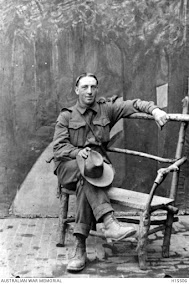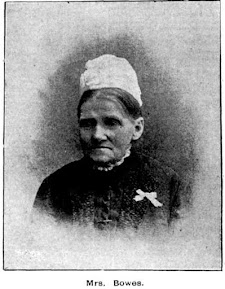At the Going Down of the Sun....
As we head towards another Anzac Day where we reflect upon the sacrifices made by others for us to be able to live the life we do in Australia, I can't help but think of those who spent time in conflicts only to return home and die in a case of somewhat serendipity.
Today's blog honours such a
person.
WILBERT NUGENT BERG
Wilbert was born in
Braidwood NSW near Canberra on the 15th of May 1896, the second son
to Walter and Ellen. The family are noted as living in Glebe by 1910, where
Walter is listed as a postmaster, a position he held until he retired.
Wilbert and his brother
Martin joined up to fight for King and Country on the 9th of February
1915 with service numbers 1132 and 1134 respectively. Martin was over 21 years
of age, but Wilbert was just 18 but with 3 years military service, 1 year
serving with the 29th Australian Rifles and was listed as a butcher,
his brother as a Civil Servant. After training, Wilbert married Mildred Nellie
Phillips like so many others did before embarkation. Both brothers departed on
board the A40 Ceramic on the 25th of June 1915.
Both brothers saw action at
Gallipoli and were promoted to Lance Corporal. After the evacuation they served
on the Western Front where they separated where Martin became a driver. From
records it is noted that Wilbert was part of the contingent that fought at
Pozieres and was wounded in action on the 5th of August 1916 with a
gunshot injury to the thigh. It wasn’t long after this that the 18th Battalion left for Belgium to recover before returning in October. Charles Bean wrote that Pozieres ridge “is more densely sown with Australian sacrifice
than any other place on earth”. In just 12 days 6,484 Australians received
injury during the final counterattack.
After convalescing, Wilbert
was transferred to the 61st Battalion, spent time in England getting
treatment for a disease and returned to fighting in France on 23rd of July 1917 once
again with the 18th Battalion and attained the rank of Sergeant on
the 1st of September 1917. Wilbert was injured on the 22nd of September whilst taking part in the 3rd Battle of Ypres or Battle of
Passchendaele. The injury, a gunshot wound to the chest, was severe enough (loss
of 50% lung capacity) to cause him to be invalided to Australia on the 15th of April 1918. (Martin saw out the duration of the war returning to Australia in
1919).
After the war Wilbert was
employed as a clerk by Smiths Newspapers Ltd., but was given the opportunity of
displaying his ability in the photographic department. In a short time, he
became one of the best photographers on the staff. He was enthusiastic and
unafraid of danger, having previously undertaken a number of daring feats
including aeroplane flights.
On Saturday the 16th of November 1929, Wilbert, whilst on assignment to take photographs for the “Daily
Guardian” of the Royal Automobile Club of Australia races at Gerringong near
Nowra , his luck ran out.
Flying conditions on the day
were not good with a strong north east wind keeping the beach lashed with waves
well above the low-water mark.
The championship race having
been decided, the officials were just arranging for a match between the fastest
car and an aeroplane when the pilot, Jesse O’Connor, and Berg decided to go up
and photograph the race before heading back to Sydney. Several witnesses state
that when the engine was started it was misfiring but it rose and reached a
great height.
With the wind behind it, the
plane moved at a good speed but when at a height of about 45 metres it turned
again, suddenly banked, stalled and plunged in a nosedive into the sea at the
first line of breakers in about 3 metres of water.
The action was so sudden
that it took a moment for witnesses to realise what had happened, but they soon sprang
into action to lend assistance as best they could in the absence of proper
equipment. Many spectators dived into the sea but the conditions rendered
immediate assistance impossible.
Wilbert’s body was found
near the wrecked plane with a badly fractured skull and other injuries but it wasn’t
for another 24 hours that the body of O’Connor, a pilot with over 300 hours
flying experience, was located.
Wilbert Berg lies in the Anglican
Section just off Necropolis Drive. His funeral moved from his home “Ypres” in
Bareema Road Lakemba to the cemetery with mourners including his wife and young
son and other family members; also in attendance were colleagues from the “Daily
Guardian” and former members of the 18th AIF Division.
It seems that Wilbert saw
the worst of Battles during World War One and having escaped serious physical
injury, he may have harboured a false sense of security. We will never know,
only that he died doing something he loved.
There are many tales of
returned Servicemen and Women who after avoiding certain death in various
battles of war lose their lives in peacetime in unusual circumstances.
For today's blog I
referenced ancestry.com, Australian War Memorial records, where you can peruse Wilbert’s
war diaries, newspaper searches of the tragedy via Trove, Wikipedia and other
Google searches.
If you have any cases of
such serendipity within your family history involving similar circumstances or
other insights, please feel free to share them in the comments below or send me
a personal message via
lorainepunch@gmail.com
I'm sure there are many such examples.
At the going down of the
sun, we will remember them.
May they Rest in Peace.
Until next week.







Comments
Post a Comment